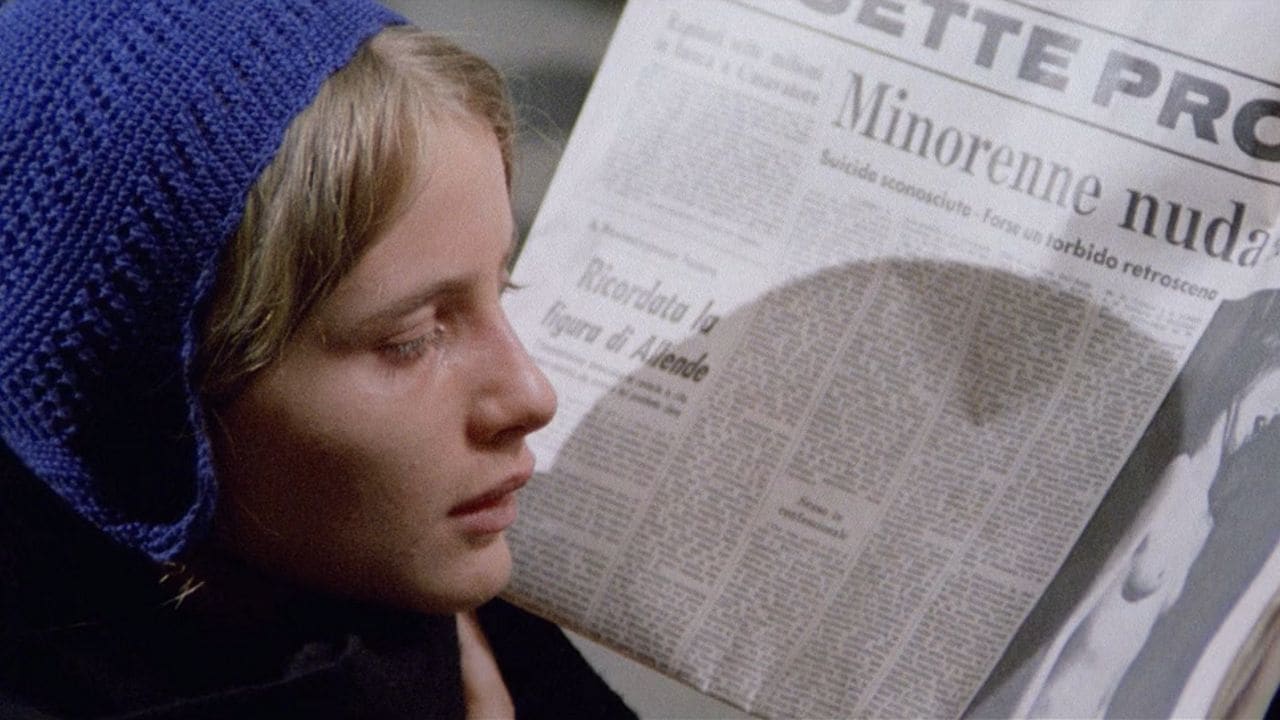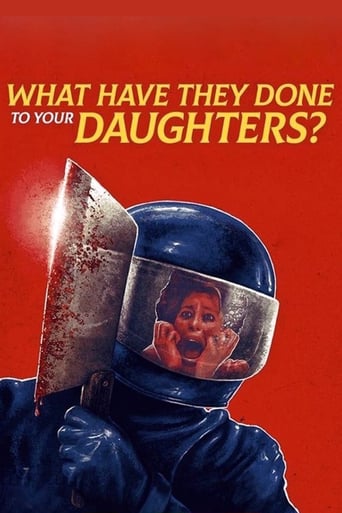

This giallo doesn't mess around: after the opening, the very first scene features police bursting into a room to find a young naked girl hanging. Dead. What makes the scenes that immediately follow so horrifyingly effective is by Director (and co-writer) Massimo Dallamano having his camera observe events from the girl's height, almost from her point-of-view, and as such, half the screen is filed with her dead face, mouth agape – almost as if she is observing events. She was promiscuous 15 year-old Sylvia (Sherry Buchanan) who promised her mother that if she told her father of her activities, she'd kill herself. And yet Sophia Loren-alike Asst. DA Vittoria Stori (Giovanna Ralli) is sure it was murder.It was felt at the time that giallo films were not as popular as they once were (which, if true, is understandable; there had been many made during the previous few years), and so this became a fusion of giallo and poliziotteschi, with more attention paid to police procedures than focusing on more 'standard' civilian characters. Dallamano made this as part of a trilogy of such films, beginning with 1972's terrific 'What Have You Done to Solange?' and ending with 'Red Rings of Fear' in 1978 (sadly, he died before completion).This slight change in style provides a welcome change in emphasis, as far as I am concerned. I find giallo a highly enjoyable genre, but this works well as an extention of that. Some truly gritty, gruesome set-pieces enlivened with Stelvio Cipriani's excellent score, ensures that the pace very rarely slackens. There are disturbing scenes too, when the police listen to recordings of intimate events occurring in the teenage prostitute ring that may or may not be behind the death. Even with the dubbed voice artists, it is uncomfortable listening. It gets even more uncomfortable when it seems Inspector Valentini's (Mario Adorf) own daughter may be involved.Alongside Vittoria Stori, we have Inspector Sylvestri (Claudio Cassinelli), who is the nearest we get to the staple of most giallos: a tough talking gent who is a bit of a twit. He comes good in the end though, reacting like granite when he helps apprehend and uncover the identity of the miscreant. Getting the authorities to act upon such a major vice ring connected to some very high places, however, is another matter. How little times change.A big hand too for the blood. Far more realistic than the bright paint used in similar films.
... View MoreThis is Massimo Dallamano's very worthy follow-up to his excellent giallo "What Have You Done to Soilange?" and the second in the director's seminal trio of "schoolgirl gialli" that managed to combine the adolescent sexual hijinx of the German "schulmadchen-report" films with a blood-soaked Italian giallo thriller plots, making for a very heady brew indeed. These films anticipated (and perhaps even influenced) the later American teen slasher films with wayward adolescent female protagonists being "punished" for their sins by a mad slasher. But where the young American slasher are guilty only of acting like typical teenagers, their Italian forebears in "Solange?" were involved in swinging sex parties and back-alley abortions, and in both this film and its follow-up ("Red Rings of Fear"), the girls have actually gone pro and started a teen call-girl ring.This film differs from "Solange?" somewhat, however, in that rather being a straight "giallo", it is also somewhat of a police procedural thriller (complete with a gratuitous motorcycle chase). The protagonists include two veterans of that latter genre--the charismatic Claudio Cassanelli as the lead detective and the great Mario Adorph, normally a psychotic heavy, but here playing against type as a distraught father. The lead though, in a feminist touch, is Giovannas Ralli as a female DA. The police are investigating the apparent suicide of a pregnant schoolgirl from a wealthy family. They connect it a schoolgirl prostitution ring servicing powerful influential men. Meanwhile, a brutal leather-clad, motorcycle-riding killer armed with a meat cleaver goes to almost ridiculously bloody lengths to cover it all up for his wealthy employers. The ending, as befitting the genre, is duly cynical.The actresses playing the "schoolgirls" in this movie are marginally more believable in their roles than the model-pretty 20-25 year olds that were in "Solange?" (The most recognizable is the lovely Sherry Buchanon, in her first role as the murdered girl). There is, however, much less graphic sex and nudity than in its predecessor, but what there is pretty disturbing in that occurs in very graphic audiotapes the police listen to. But thanks to great editing and cinematography by Dallamano and co.--and one of the best soundtracks of any 70's Italian exploitation film--this is nowhere near as sleazy as it ought to be (especially compared to some of its truly sordid imitators like "The Teenage Prostituion Racket"). Highly recommended.
... View MoreWhile the original Italian title – THE POLICE ASKS FOR HELP – clearly pigeonholes this one in the then-popular (and incredibly prolific) poliziottesco genre, the English title under which it is better known around the world – WHAT HAVE THEY DONE TO YOUR DAUGHTERS? – implies a giallo in the same vein as Dallamano’s best-known film, WHAT HAVE THEY DONE TO SOLANGE? (1972). In any case, while both elements are effectively present – a hatchet-wielding murderer is the subject of the climactic manhunt – the police procedural themes are more prevalent.The film deals with a teenage suicide which eventually uncovers a child prostitution ring which, as usual, includes not just the petty sleazy oddballs (here personified by Franco Fabrizi) but also high-profile professionals (a celebrated doctor) and high-ranking government officials (a Minister). The cast is surprisingly good for this type of genre effort: Claudio Cassinelli (as the investigating Police Chief), Giovanna Ralli (unusually cast as a female D.A.), Mario Adorf as the policeman who finds the first body and also discovers that his own teenage daughter was once a “victim” of these perverts, the afore-mentioned Fabrizi and Hollywood veteran Farley Granger in a smallish role as the first victim’s father.As usual for Italian genre movies, the music score is an asset and here it is provided by Stelvio Cipriani whose motif, while simple and repetitive, is extremely effective given that it involves children singing gibberish (and thus commenting on the main theme of the movie itself even through its performers). Alarmingly, the end titles claim that every year in Italy, 8000 teenagers run away from home but only a small percentage returns to the fold – the majority are never found!
... View MoreThe lifeless body of an attractive teen girl is found in a dusty attic. She's hung and everything points in the direction of a suicide. Closer investigations, however, points out that the girl has been murdered elsewhere before dragged into the attic. The discovery of the corpse slowly unravels a network of teen-prostitution in which several eminent civilians are involved. This hardens the police investigation while the killer (on a motorcycle and carrying an authentic butcher knife) is still on the loose. `What Have They Done to Our Daughters' is kind of like a sequel to `Solange' (or fully entitled: What have you done to Solange'). The stories don't follow each other but they handle about similar events: young schoolgirls caught in a web of unsettling and sleazy affairs. Both films are above average gialli, with an incredibly high tension-level and killer musical scores. Even though `Solange' upholds the mystery longer and more efficiently, this film contains a little more action. Best example to state this is the extended police car versus motorcycle chase through the beautiful streets of Italy. The budgets, however, are low so don't expect blood-soaked murders like the ones featuring in Dario Argento gialli.
... View More